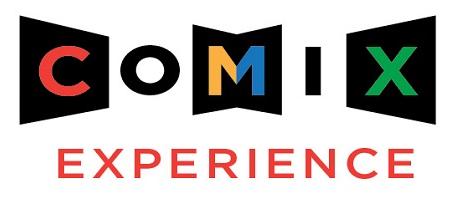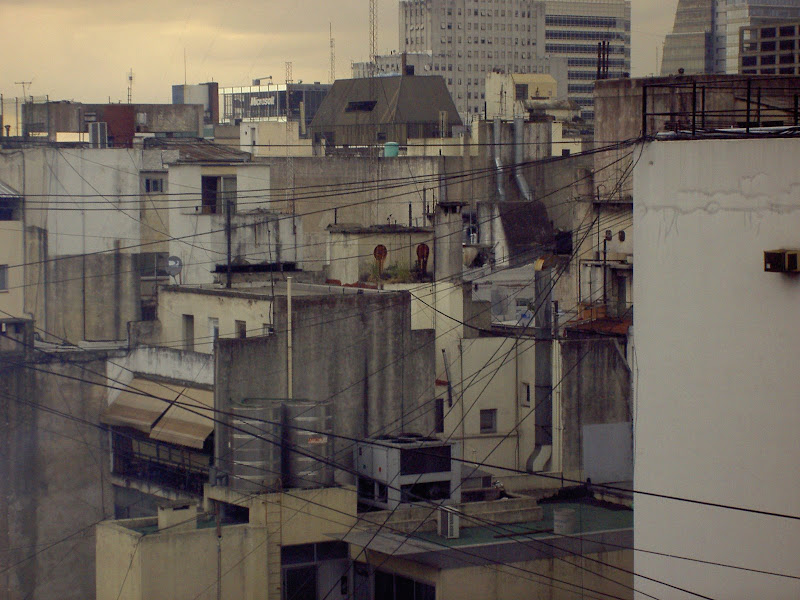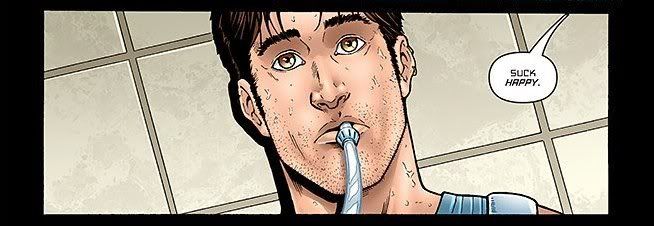Lots of retailer-driven conversation this weekend, and we'll get to the main show in a second, but I realized I forgot to post a link to the newest TILTING AT WINDMILLS on Newsarama. This month I dissect a Dan DiDio quote about branding and COUNTDOWN, as well as talk about the move to an "annual" format for LOVE & ROCKETS.
If you have anything you want to chat about that piece, but don't want to dive into the morass that is Newsarama's Board feel free to use the commenting section below!
On Friday, ComicsPRO released the newest Position Paper on Pre-sales at Conventions. Oddly, you wouldn't know from the actual news sites, I've yet to see anything turn up on them as of yet.
I'd also strongly suggest that people go and read the comments on Johanna's piece about the paper, as I think there's a lot of pretty high-level quality commenting going on by many retailers there.
There's also Tom Spurgeon's thoughts here, as well as my reply to Tom, and his reply to that over here. We'll get back to that in a little while.
Finally, there's a plethora of commentary by Alan David Doane.
So, go read all that and come back.
I'm going to start with that last one, because ADD and I... well I don't know, we generally don't get along, I guess? He's famous for saying "Die, Direct Market, Die!", and as a participant in the Direct Market I oddly take offense to that!
Some of Johanna's comments also fall under the "Well, a lot of comic shops suck; so screw them!" defense (though Johanna, at least, tends to be much more deeply nuanced and also tends to be at least concerned with the changing and/or increasing demographic of READERS who, say, don't want to drive xx miles to a quality comics shop, or would rather buy on-line for a variety of reasons, etc.), so let's start off there.
OH, and lest it be misconstrued, I am, as always, speaking as an individual here, not as a representative of ComicsPRO or its Board.
ComicsPRO is an organization of Direct Market retailers who are trying to make things better for ALL retailers. I have and will probably always stipulate that many stores stink on ice, but I don't see any real relevance in that in terms of a ComicsPRO position paper.
Why?
BECAUSE COMICSPRO MEMBERS ARE NOT THE "PROBLEM" STORES.
(Well, or at least insofar as I know of their individual operations through anecdote and conduct -- I've certainly not personally visited more than a quarter of the membership, at most)
ComicsPRO is, by and large, "the best and the brightest" retailers. The smart ones, the passionate ones, the forward-thinking ones. The ones who outreach to their communities, the ones who get nominated for Eisners, the ones who strongly support as wide a range of material as they can. They're the early-adopters, they're the knowledgeable fonts, they're the communicable-passion carriers who work god-damn hard to move comics forward.
So any argument or debate that is predicated on a "DM stores are lousy, so why should we support stores that don't support us?" is, I think, shredded on contact with ComicsPRO membership -- these stores are NOT lousy, and these stores DO support you.
ADD's suggested position paper (his last link above) is pretty laughable in consideration of ComicsPRO's membership. I'm reasonably sure that virtually 100% of the membership would meet virtually 100% of ADD's requirements. And the ones that don't are actually a matter of ADD's preferences or misunderstandings rather than actual signs of professionalism.
Here, I hadn't intended to do this, but since I have that window open, let's discuss a few of those points.
Professional comic book stores do not favor one genre or sub-genre over another.
Professional comic book stores recognize that all comics are comics, no matter what country they originate from, or what format they are published in.
I might (just barely) support language that said "Professional comic book stores recognize that all comics are comics, no matter what country they originate from, or what format or genre they are published in", but as written this couldn't possibly be something that ComicsPRO could possibly endorse.
Why? Well, let's put it this way, would the American Bookseller Association release a policy that said that Mystery- or Science-Fiction-focused bookstores couldn't be considered "professional" bookstores because of their mono-focus? OF COURSE NOT. In exactly the same way, and for exactly the same reasons, ComicsPRO can't and wouldn't say "you can't focus on action/adventure genres" -- in exactly the same way we can't and wouldn't say "you can't just focus on manga" (as a small handful of stores in America are doing)
Like ADD, I personally and individually want to see stores offering me the kinds of comics I enjoy as a reader -- be that PERSEPOLIS or GREEN LANTERN or BONE or EXIT WOUNDS or FART PARTY or whatever; but unlike ADD, I know for a fact that business owners have every right to make the decisions they want as to THEIR vision of THEIR stores. Some retailers are in conservative communities, some retailers are running pop-culture stores, not comics-as-literature stores, and some retailers are simply following the trends of what their actual customers are actually buying, and weighing their stores appropriately. Who the fuck am I to tell them they're wrong or right?
Taken literally, ADD's first point would mean that a manga cafe like New York's Atom Cafe wouldn't be considered professional, and couldn't join ComicsPRO. (They haven't, but of course they COULD)
If what you want to say is that "Professional comic book stores are quick and willing to take reasonable special order requests" then that might be something that could hold up -- but you simply can't insist that a Mystery bookstore sell cookbooks to be considered professional.
I'm totally sympathetic to what ADD's intention here is -- he wants more stores that a family of four can walk into and walk out with something for each person, but that's not something that can be "legislated" or codified in a way that won't exclude some one you didn't intend, or, for that matter, that would stand up to anti-trust scrutiny.
And frankly, I'm not sure that there aren't quality professional retail stores that ALAN (and I!) wouldn't shop in but that DO satisfy THEIR customers in that all-four-walk-out-happy, just maybe not all four with a comic.
Moving forward, Alan offers this one:
Professional comic book stores recognize the transition from periodical pamphlet comics to more appealing and enduring graphic novels, and accommodate the readership’s clear preference for comics with a spine and a complete story.
Much like the above, I think you'll find that many many stores are not experiencing this. Stores that are not, in any way, "unprofessional"
I'm a book-oriented store, I've championed comic BOOKS nearly my entire professional life (Man, it was me and Rory Root and Bill Liebowitz in that LA conference room nearly 20 years ago now that helped convince the DC that, yes, there was a tremendous potential in their backlist. It was maybe 20 titles deep back then?) so you don't have to sell me on the concept, kiddo -- but the periodical is still a VERY viable format, and one that if you even just glance at ICv2's reports is pretty clear is still on a multi-year growth curve.
Books are TOO, but like the above, there's absolutely no way we can (or should) legislate what or how people stock or in what balance.
As I say, I run a comic BOOK store, I prefer selling trades to periodicals, and that's where our focus and energy is, but periodicals still sell VERY well, and, increasingly to the very "civilian" customers that ADD makes sweeping pronouncements about. DARK TOWER, BUFFY SEASON 8 are great examples -- those sold like MONSTERS, largely outside of the "Wednesday regulars", and people seemed to LIKE the serialization (they kept coming back, after all). For us, at least, the collections of these comics are doing well, but we sold at least 5x on BUFFY #1 than we did of v1 TP, and DARK TOWER is probably run 7x or so.
This is the last one, ADD says:
Professional comic book stores actively seek to buy from a variety of distributors, not relying on one monopolistic distributor for the entirety of their business, and not settling for receiving books “whenever Diamond ships them,” but rather, as soon as they are available, in order to better serve their customers.
Heh. OK, first, you're not going to get a ComicsPRO position paper that will specifically call out one vendor or supplier by name. Besides being beyond tacky, and needlessly confrontational (and more on that later), there are federal anti-trust issues that would absolutely forbid that. Jinkies!
Second off, regular readers will know that I have my fair share of complaints with the way Diamond conducts business, but one thing that Diamond usually does pretty well is moving items from point A to point B accurately and quickly.
In terms of exactly what moves when, these are largely questions of point of printing and point of receipt and timely notification of solicitation. There's plenty of plenty of stuff that comes faster via Diamond than it does from B&T, or even direct from the publisher.
But speed alone isn't the sole consideration here -- there's also cost. There's a lot of calculation that needs to be made in terms of shipping costs, manpower, and discounts when looking at what is the "right" source to buy from. For example, I buy most of my "New" Fantagraphics books from Diamond, UNLESS it's a book that I'm ordering 10 or more, then I'd go to B&T, UNLESS its 20 or more, then I'd probably go direct to FBI. It's all a matter of discount and shipping costs -- buying that book from FBI means I have to pay shipping on it, whereas B&T has $1 freight. With B&T, the increase in effective discount is about a half-percent better on 10 or more copies over Diamond, otherwise Diamond is the cheapest source. Diamond's also the SOLE distribution source for much of FBI's periodicals. If you buy a book NEW from FBI direct, you get a much better discount, but if its shipping from the printer, the freight costs tend to eat all of your profit because they're sending a single title. If you wait for it to ship from the FBI warehouse along with reorders, you're often adding a week or two to the process.
And so on and so forth.
On the other hand, I buy virtually none of my FBI backlist from Diamond -- that either goes direct, or formerly through Cold Cut, and some through B&T if I need something right away. Diamond's my tertiary source because of their reorder fee, and often lackluster stocking commitment.
The decision of WHERE to source a book is very much an INDIVIDUAL BUSINESS decision, and has more factors than ADD seems to want to allow for. And I'm not so sure that speed of delivery alone is the right metric to judge for a profit-focused/needed small business.
Otherwise, I wholly agree with ADD's other points -- being clean, organized, well lit, open on time, and so forth. But there's a big part of me that feels that's like issuing a position paper stating that we feel that water is wet, and the sky looks blue, and that fire can burn. There are pretty much already zero-point conclusions for ComicsPRO's membership.
Months ago there was a bit of discussion about having a professional standards paper, but no one stepped forward with a first draft, so I think it went into limbo. But I'll tell you what, I'll post a link to that discussion (and this one) in the ComicsPRO message board, and we'll see if we can find any advocate for putting out a Standards paper. Again, water is wet, but it certainly can't hurt...
I have a little more to say, because I want to comment on Tom's comments, but let's save your attention span and put that into a separate post. See you in an hour or two, I hope....
-B
















